» Site Map
» Home Page
Historical Info
» Find Friends - Search Old Service and Genealogy Records
» History
» QAIMNS for India
» QAIMNS First World War
» Territorial Force Nursing Service TFNS
» WW1 Soldiers Medical Records
» Field Ambulance No.4
» The Battle of Arras 1917
» The German Advance
» Warlencourt Casualty Clearing Station World War One
» NO 32 CCS Brandhoek - The Battle of Passchendaele
» Chain of Evacuation of Wounded Soldiers
» Allied Advance - Hundred Days Offensive
» Life After War
» Auxiliary Hospitals
» War Graves Nurses
» Book of Remembrance
» Example of Mentioned in Despatches Letter
» Love Stories
» Autograph Book World War One
» World War 1 Letters
» Service Scrapbooks
» QA World War Two
» Africa Second World War
» War Diaries of Sisters
» D Day Normandy Landings
» Belsen Concentration Camp
» Italian Sailor POW Camps India World War Two
» VE Day
» Voluntary Aid Detachment
» National Service
» Korean War
» Gulf War
» Op Telic
» Op Gritrock
» Royal Red Cross Decoration
» Colonels In Chief
» Chief Nursing Officer Army
» Director Army Nursing Services (DANS)
» Colonel Commandant
» Matrons In Chief (QAIMNS)
Follow us on Twitter:

» Grey and Scarlet Corps March
» Order of Precedence
» Motto
» QA Memorial National Arboretum
» NMA Heroes Square Paving Stone
» NMA Nursing Memorial
» Memorial Window
» Stained Glass Window
» Army Medical Services Monument
» Recruitment Posters
» QA Association
» Standard
» QA and AMS Prayer and Hymn
» Books
» Museums
Former Army Hospitals
UK
» Army Chest Unit
» Cowglen Glasgow
» CMH Aldershot
» Colchester
» Craiglockhart
» DKMH Catterick
» Duke of Connaught Unit Northern Ireland
» Endell Street
» First Eastern General Hospital Trinity College Cambridge
» Ghosts
» Hospital Ghosts
» Haslar
» King George Military Hospital Stamford Street London
» QA Centre
» QAMH Millbank
» QEMH Woolwich
» Medical Reception Station Brunei and MRS Kuching Borneo Malaysia
» Military Maternity Hospital Woolwich
» Musgrave Park Belfast
» Netley
» Royal Chelsea Hospital
» Royal Herbert
» Royal Brighton Pavilion Indian Hospital
» School of Physiotherapy
» Station Hospital Ranikhet
» Station Hospital Suez
» Tidworth
» Ghost Hunt at Tidworth Garrison Barracks
» Wheatley
France
» Ambulance Trains
» Hospital Barges
» Ambulance Flotilla
» Hospital Ships
Germany
» Berlin
» Hamburg
» Hannover
» Hostert
» Iserlohn
» Munster
» Rinteln
» Wuppertal
Cyprus
» TPMH RAF Akrotiri
» Dhekelia
» Nicosia
Egypt
» Alexandria
China
» Shanghai
Hong Kong
» Bowen Road
» Mount Kellett
» Wylie Road Kings Park
Malaya
» Kamunting
» Kinrara
» Kluang
» Penang
» Singapore
» Tanglin
» Terendak
Overseas Old British Military Hospitals
» Belize
» Falklands
» Gibraltar
» Kaduna
» Klagenfurt
» BMH Malta
» Nairobi
» Nepal
Middle East
» Benghazi
» Tripoli
Field Hospitals
» Camp Bastion Field Hospital and Medical Treatment Facility MTF Helmand Territory Southern Afghanistan
» TA Field Hospitals and Field Ambulances
Annie Hughes RRC QAIMNS World War Two Diary Palestine
This war diary was written by Matron Annie Hughes RRC of the Queen Alexandra's Imperial Military Nursing Service (QAIMNS) and was published as a paper back booklet at Rhyl Journal office and is reproduced here with kind permission of her neice:
Leaving York Military Hospital to embark at Southampton under secret orders to an unknown destination, I met a small hospital unit on the quay, also some troops of well-known regiments. It was a bitterly cold, rainy day, in fact what you would call a filthy day.
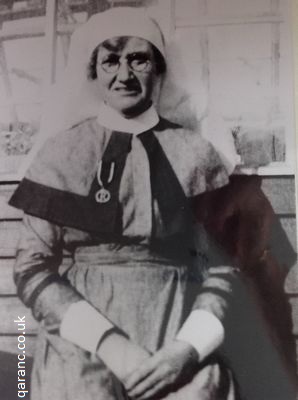
The troopship detailed for the trip was found on inspection to be unseaworthy. Standing by was a Canadian luxury cruiser, Montclare, waiting to take on board a party for a Mediterranean cruise. It was fitted up and its larders filled with wonderful rations. This ship was commandeered by the military authorities to take us on our journey. Our unit was urgently needed and little did we realise that this was going to be our last good rest and meals for a few years.
Leaving the white cliffs of Dover and making for the open sea, the passage through the Bay of Biscay was very rough. Most of the troops spent two days in their cabins, but the nursing sisters proved to be good sailors. The sight of the Rock of Gibraltar broke the monotony, then the passage along the barren Algerian coast. For the passage through the Spanish area we had to have an escort because Franco was not friendly towards us. The passengers had to keep in the background so that it would not be known the ship was carrying troops.
Making for the open sea again, with nothing in sight but the odd ships in the distance, we had our orders of destination, which was various parts of Palestine. By this time the climate was changing and getting very warm so that we had to get into tropical kit. The ship made straight for Haifa, the weather getting hotter, entering into the harbour after passing along Acre Bay with its mass of golden sands, and great oil tanks belonging to the IPC. The great Mount Carmel looking down on the quay and town made a wonderful picture. When the ship docked shouts from the coolies and Arabs was deafening, but what a shock they received when troops disembarked instead of wealthy holidaymakers. Only a few coolies had been allowed on the quay under very strict supervision of Military Police. They soon sent signals to their friends outside the gates. On the quay waiting for us were escorts fully armed, and commandeered Arab buses with all windows covered with fine wire mesh and made bullet-proof. When we saw this it began to dawn on us what to expect. At this time it was necessary for the UK to do something for this country as the terrorists and bandits were causing a lot of trouble by bombing and setting fire to all the important buildings, shooting officials, etc.
They waited for our buses to come out of the harbour gates and what a reception they gave us! We had all the rotten fruit they could lay their hands on and gave us a rel good pelting so that it was a relief to get away from the town. The place that the military authorities had taken over had been an Arab technical college six miles out of the town and alongside the oil refineries on the Acre and Beirut road, passing through areas that had been destroyed in the riots. Our transport passed over a roughly made stone bridge with the river Kishon running under and making to the sea.
Arriving at the school, which stood in a compound with barbed wire all around, it was found that tents had to be put up. The only building apart from the school was a schoolmaster's house and not big enough to sleep twelve sisters in. This we used for the sisters' mess, By this time it was getting dark - in these parts days light disappears almost at once - and we did want a cup of tea having had our last meal on the ship at midday and issued with iron rations (bully beef, hard biscuits, tin of milk and a piece of cheese) to bring with us. We also had our campbeds to put up. Well this meant getting down into our kitbags and bedrolls, getting out our only light, having oil put into the small hurricane lamps and primus stove, finding a mug and , eventually, having our ell earned tea.
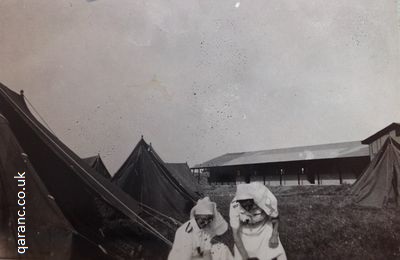
Digging ourselves in, feeling very tired and really browned off, thinking that perhaps after a night's sleep and able to look around in daylight things would not be so bad, but what a night! The bandits began to fire over the compound from off Mount Carmel and its wadis. The hyenas and jackals prowled around looking for something to eat and making a terrible noise. These animals hunt in packs and are always led by a hyena with its laughing bark. Our troops fired in return, and it was nice to see daylight coming. Some of the troops other than the RAMC had been out all night hunting the bandits who lay hidden, and almost before we got the hospital going the casualties began to come in.
The nursing staff and orderlies after having a so-called meal had detailed for the various duties. Mine was the supervision of meals, relief for operating theatre, lectures to orderlies, and two sisters for night duty. The matron in charge had been notified that I was coming out with this unit., we having met before at the Millbank Military Hospital during the Abyssinian War in 1936. My first task was to find native servants for the sisters' mess. To do this meant going into the town where they threatened to take our lives, but anyhow a strong armed guard with transport was detailed to take me. I met some English wives of the oil company and they helped me a lot. Eventually we got settled in, as I thought, and all went well for a few days, but they began to quarrel amongst themselves and they were not clean enough for us. They also resented not being allowed out of the compound without a special pass. These strict precautions had to be taken, it being a danger zone. In the end I cleared then out and made another try. This time I found a Sudanese cook who had been with an IPC family for some years, they having had to return home because of the trouble and as it was no place for children. He turned out to be a real treasure, a jolly good cook and spotlessly clean. He told me not to worry about other servants as he would get them, which he did, and very nice men they turned out to be. They looked after the staff very well and felt very proud to be allowed to look after us. They made things easier for me, but I spent very few nights in bed for a few weeks because of the heavy casualties that came into the hospital during the night and often meant that the theatre was kept busy.
There was a small RAF station alongside us for helping the ground troops. Italian planes used to come down on the station twice a week, this of course, being before the outbreak of World War II. The RAF used the small Gladiator machines so that they could fly low and get in between the rocks. When they spotted the bandits they sent off flares, then a big raid would take place with good results in either dead or prisoners. Many of these brave boys received the DFC for services rendered in Palestine. Lady McRoberts' youngest son was one of these boys.
When necessary shopping had to be done transport complete with officer and armed guards were detailed. They would clear all natives out of the shops before we entered (we had to go in parties), then one officer would remain alongside us until all purchases had been completed.
The RAF put up a searchlight on the flat roof of the hospital and at night it showed up the hills and lonely roads for miles so that the bandits coming from their hide-outs were soon spotted. Many times the sandbags protecting the revolving light would collapse from rifle fire. The light also showed up the wild beasts prowling. One night a sister called out that a huge cat was curled up asleep on her bed, but it turned out to be a jackal who must have lost its friends. We always knew when they were about because the hyenas led them and sort of protected them when they smelt danger.
Many of our trucks and lorries got blown up by the home-made mines. The terrorists would send Arab children around the Army dumps to collect the empty beer cans. They would then fill them with explosives and attach cotton to the tins, the cotton matching the colour of the sand or road. The mines would then be placed in the way of the transport, a bandit remaining in hiding who would give the cotton a pull so as to place the explosive in position for the truck wheels to pass over it. After a few casualties and loss of rations, our boys made their own arrangements and became aware of this stunt and that it did not happen so frequently.
One night early in November the rains came. What a relief after the dreadful heat, but what chaos! It was so heavy that the tents all collapsed, some sisters were still in their beds and by the time they were rescued we stood knee deep in the water but managed to get to the sisters' mess. This meant looking for billets. There was nowhere in the compound, so a large German hospice on the top of Mount Carmel was taken over for the staff with the exception of the matron and myself as we had to hold the fort and help the night staff when necessary. The staff had to be taken to and from duty under an armed escort, also a guard to remain at the hospital. One day when coming on duty in the morning they found lying across the entrance to the hospital a wrecked train, this having been blown up during the night. They had to climb over it to get into the hospital.
We were fortunate in having the hospital very near the sandhills, a few minutes walk to the sea, so when off duty we were able to go for a daily dip into the lovely blue water of the Mediterranean. This again could only be done if a guard was available to look after our clothing. The Arabs were such thieves that they would lie in wait ready to steal our towels and clothes. Officers taking early morning dips would often be seen returning to their quarters minus clothing and no towel to put on.
One afternoon I went up to the hospice, which overlooked Haifa Bay, and watched a real good dog-fight between a German plane and the RAF. It was terrific. The bombs dropped made the surrounding sea look like a lot of huge waterfalls. The German plane came down in flames into the sea, ours returning safely to base. The enemy had been over several times to try and sink two troopships in the harbour ready for troop movement. At this time things did not look very rosy for us, and the Italian planes had been acting rather boldly for a few days, coming in more frequently and flying over the hospital much too low for our liking. Then the news arrived that Italy was at war with us. The planes stopped coming. Signals came through for us to evacuate within forty-eight hours, but by this time we had over five hundred men in the hospital, some very badly burnt cases from truck casualties, and quite a number brought in after the battle in the Mediterranean.
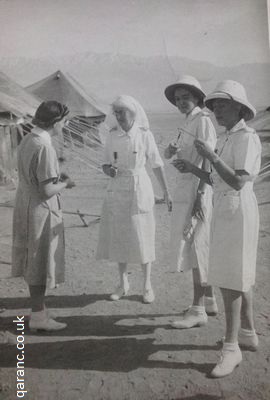
I was sorry to leave this part now the momasha trees were at their best, date palms hanging heavily with blossom, the village natives busy collecting the fibre from the trunks of the palm trees to make shoes, baskets, mats and even clothing. Then along the Beirut road to the small native mud-hutted village of Acre (spelt "Accho" in the Old Testament). Here there is an old fortress still used as a prison, on the walls of which you can see cannonballs embedded from the bombardment by the British, Austrian and Turkish fleets in 1840AD. It was taken by the British from the Turks in 1919 AD.
Easter 1939 I had a few days leave and went to Jerusalem by car. Leaving Haifa and travelling for miles along the Mediterranean coast road, we passed through a place called Athlet, a magnificent fortress built in red stone but now in ruins. This fortress formed the last stronghold of the Jewish Templars in Palestine in 130AD and of Jewish independence. It was at Athlet that the remnants of the Crusaders assembled on the night when they decided to abandon the fortress under cover of darkness and escape to Cyprus.
A few miles further along on each side of the road, were orange and grapefruit trees. The scent of the blossom was almost over-powering and took one's breath away, and it was nice to leave them behind and get into open country with its mud hutted Arab homes and barren hills.
Follow us on Facebook, Instagram and Twitter.
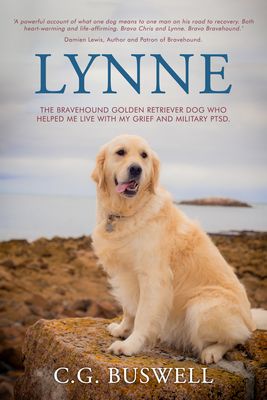
My PTSD assistance dog, Lynne, and I have written a book about how she helps me with my military Post Traumatic Stress Disorder, anxiety, and depression. I talk about my time in the QAs and the coping strategies I now use to be in my best health.
Along the way, I have had help from various military charities, such as Help for Heroes and The Not Forgotten Association and royalties from this book will go to them and other charities like Bravehound, who paired me with my four-legged best friend.
I talk openly about the death of my son by suicide and the help I got from psychotherapy and counselling and grief charities like The Compassionate Friends.
The author, Damien Lewis, said of Lynne:
"A powerful account of what one dog means to one man on his road to recovery. Both heart-warming and life-affirming. Bravo Chris and Lynne. Bravo Bravehound."
Download.
Buy the Paperback.
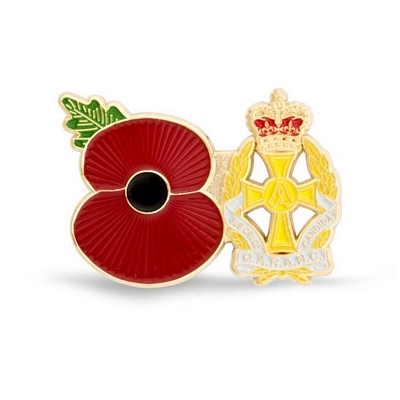
This beautiful QARANC Poppy Pin Badge is available from the Royal British Legion Poppy Shop.
For those searching military records, for information on a former nurse of the QAIMNS, QARANC, Royal Red Cross, VAD and other nursing organisations or other military Corps and Regiments, please try Genes Reunited where you can search for ancestors from military records, census, birth, marriages and death certificates as well as over 673 million family trees. At GenesReunited it is free to build your family tree online and is one of the quickest and easiest ways to discover your family history and accessing army service records.
More Information.
Another genealogy website which gives you access to military records and allows you to build a family tree is Find My Past which has a free trial.
Passing through Sarafand and Ramleh, with the wide clean looking roads, I stopped to visit the British cemetery in Ramleh where are the graves of our troops who gave their lives in World War I. There were hundreds with wooden crosses, some with gravestones: all with lovely flowers growing on each grave and marked with name and regiment. The keeper of this well-kept place was a sergeant-major of World War I who remained behind in Palestine. He gave me a beautiful bunch of flowers to put on one grave. It was all so silent and peaceful.
Lydda at this time was being churned up to make an airport, which turned out to be a vry important one. (This place is spelt "Ludd" in the New Testament). Legend of the sixth century states that St. George of England came from here.
Jaffa is one of the oldest cities in the world and is famous for its beautiful gardens and orange groves, also bees: honey being plentiful and tasting chiefly of orange. Jaffa natives are a friendly and Christian race. They like to tell you that this is the place and scene of Jonah and the whale: also from Jaffa the cedars of the Lebanon had been carried by water to build Solomon's temple, and Tabitha was restored to life. There was quite a nice hotel here with its own beach alongside the sea. It was a very hot day, so I stayed for a meal and rest, my little dog and companion being glad to cool herself in the water though she was a wonderful traveller.
Judy, Matron Hughes dog, climbing the steps at Petra Lebanon.
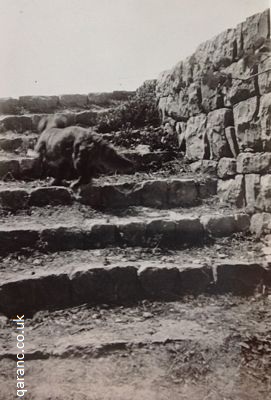
My next port of call was Tel Aviv. This is a very modern Jewish city with magnificent buildings and hotels built only for the wealthy. You could buy almost anything providing you had plenty of money and most of the goods seemed to be American. I stayed here one night in a room overlooking the sea, and what a treat it was to be able to have a proper bath! I was very amused to see a notice on the wall in the hotel which stated "if you have any complaints please inform the management who will try to improve on them."
Leaving Tel Aviv early next morning before it got too hot, the travelling was through hilly country. There were seven hills, one after the other, known as the Seven Sisters and, ascending the last one, I got my first sight of Jerusalem and it was a thrill. This happened to be the evening before Good Friday. I went to stay with a charming Scots lady and her husband who had come out to start a mission but when troops began to arrive they bought a large hut and opened it up for a YMCA so that the boys would have somewhere to go as it was not safe for them to walk the streets, there being far too much trouble on. The troops loved them. Their house was built on Mount Zion overlooking the Mount of Olives and Mount Scopus. That evening they took me to the Passover service which was held in a wonderful building known all over the world with its huge pillars and different section carvings and mosaic work. This was Jerusalem's YMCA Usually they have processions on this occasion, but due to the disturbance the military authorities forbade any demonstrations.
Next day being Good Friday, I walked to the Garden of Gethsemane and on to the Garden Tomb. The Gardens are looked after by the Franciscan Order of Monks. They also look after the church in the grounds. The garden had masses of lovely Parma violets and one of the fathers seeing me looking at them and smelling them gave me a bunch, also a sprig off the very old olive tree which is a branch of the original tree our Lord stood under.
Walking up St. Stephen's Hill I came to the Garden Tomb, it being a hole in the rock under Mount Calvary. Alongside the hole was a huge rock discoloured with age and supposed to be the one that was rolled away. I went into the Tomb and on the floor was a stone slab almost the shape of a body, just as if it had not been set quite hard enough. At the head and foot of the slab was a large stone where Mary saw the Angels siting. I sat on one of the stones for a few minutes meditating. It gave one a peaceful feeling in spite of what was going on around us. When I was resting in this cool place a lady came in dressed in the uniform of the Salvation Army. She was on her way home to Australia from China and felt she had to pay a visit to the Holy Land. We struck up a friendship and decided to explore together. By this time it was eleven o'clock on Good Friday morning, so we thought it would be nice to visit Mount Calvary. We found it was a Moslem burial ground where Christians are not allowed, but the Salvation Army uniform persuaded the gatekeeper and we got through.
Standing where the Crosses had been, the hilltop was covered with blood red anemones in full bloom. Legend says that in this area Christ remained until four o'clock in the afternoon of Easter Sunday in the very hot sun. On the hill overlooking the Garden Tomb are two large caves which from a distance look like eye sockets. This is called Golgotha. On this Good Friday everything was quiet in the old city, the only sound being that of guns in the distance and in the wadis on the lonely Jericho road.
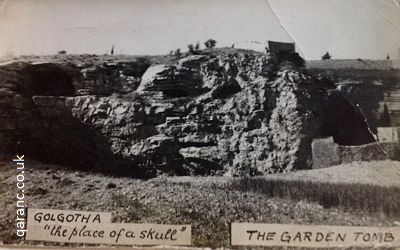
Next day we paid another visit to the Garden of Gethsemane and visited the Denomination Church which is built in the Garden. On a rock in this large church was a small chapel called "The Chapel of Agony" with a beautiful gold oil painting at the back of the altar of the Last Supper. Nearby was a large stone railed off so that no one could walk over it, for on to this stone is where the sweat from the brow of Christ was supposed to have fallen to the ground mingled with great drops of blood from the wounds on his forehead pricked by the Crown of Thorns.
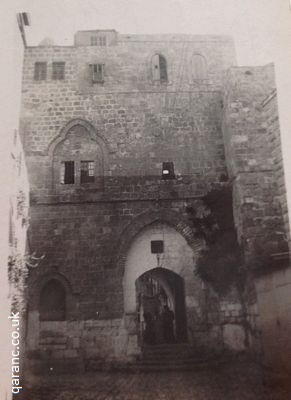
Outside the gates of the Garden, below the church, is the Kedron Valley. Here was a vault also railed off stating "Here lies the Virgin Mary, the Mother of Jesus Christ." This valley lies on the side of Mount of Olives, looking barren with nothing growing on it, not even a blade of grass, yet at the foot was another British cemetery of World War I where flowers of all kinds grew. It seemed so unusual.
Easter Sunday. The army chaplain held early morning service at the Garden Tomb. It was most impressive and real. We went home for breakfast then proceeded to St. Stephen's Gate hoping to get into the Old City. At this time the Old City, which is surrounded by a wall, was out of bounds to British troops, except those on duty. It was a danger zone and much fighting and bomb throwing had been going on, but after being advised to put on mufti we returned and the Palestinian Police gave us protection. It was most interesting. A religious procession was about to begin through the Old City of nuns and priests and a few Christian Arabs. They were praying and chanting. We joined in walking along the narrow cobbled street called the Via Dolorosa (or The Way of the Cross). This street had numbers marked on the walls every few yards which they called stations, and at each Christ was supposed to have rested, or something happened.
The first station was Judgement Hall. Second, the Echo Arch, where they put the Cross on His back. Third, the Damascus Gate, where He fell under the weight. Fourth, Christ met his mother. Fifth, Simon was compelled to help Him to carry the Cross. Sixth, the Tomb of Veronica: she also lived on this spot - Legend of the Napkin - she was a Roman lady who wiped the sweat from His brow with her handkerchief and became a Christian and suffered. Seventh, fall of Christ, here they built a "Copic monastery". Eighth, where Christ met a group of women weeping. He spoke to them. Ninth, he fell again, they built the Church of the Holy Sepulchre. Tenth, Diversion of Vestments. Eleventh, where the Cross was erected. Twelfth, where Christ was nailed to the Cross.
There is a difference of opinion about the last resting place. Many say that in those days they did not bury anyone inside the city walls. The Gardens and Golgatha and Mount Calvary are all outside the city. A story is told in Jerusalem that Constantine and his mother became Christians and were anxious to erect a church over Calvary. Helena is said to have had a dream, and in this dream a vision appeared which showed her the place where the cross and the body had been placed. She hurriedly had excavations made at this spot and three crosses were discovered, she believing then to be those of Christ and the Two Thieves. Some religions believe that the Church of the Holy Sepulchre was the original Mount Calvary. (This was the church they built). In this church, tucked away in a corner, are two oval-shaped holes, in one a tombstone surrounded by rock walls black with age. This stone is believed to hold the remains of Christ, and it is visited each year by thousands of pilgrims. Through the placing of hands and lips on this stone, it shines like glass. In another part there is hanging on the wall a full-sized cross made of olive wood which they call the Cross of Jesus. Notices are displayed everywhere in four languages - English, Arabic, Hebrew and Greek.
The Pool of Bethesda:
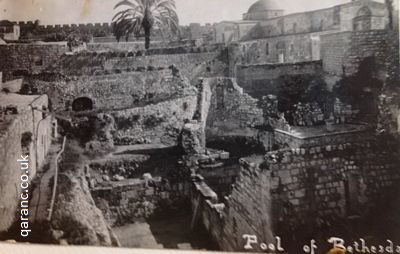
The Church of the Holy Sepulchre is dull, dark and with a musty smell. The floors are of rough stone and the walls are black with age. Lots of artificial flowers are hung about and ordinary oil lamps are for lighting. Entrance is by means of two small doors, so that only one person can go in at a time. Just inside the door was a figurehead of Mary with jewels hanging about it. These are supposed to be valuable and are strictly guarded, having been placed there by wealthy pilgrims in appreciation of having been restored to health. During the Greek Easter Week special services are held in one part, and here again there are two large oval-shaped holes through which they thrust sacred fire.
Some years ago a bishop was approached by a blind woman pleading to have her sight restored. He had not performed miracles, but offered to pray for her. At the time the candles on the altar had not been burning, when suddenly they burst into flames and at this moment the woman received her sight. Every year pilgrims arrive at Easter hoping for miracles.
The present Old City wall is not the original, the first having been destroyed by an earthquake. Inside the City Wall in spite of having monasteries, convents and churches, including zuks (bazaar) filled with all sorts of things, it is very dirty, the eatables black with flies, the smells appalling and moneylenders doing a roaring trade. Over one shop I saw a notice reading "Second hand coffins for sale" the explanation for this being that when passing a poor native burial ground one evening I saw some Arabs busy digging up coffins that had only been in the ground a short time. They emptied the remains into the hole, loaded camels and asses with the coffins and sold them back to the traders or zuk carpenters.
The hymn "There is a green hill" brings to mind that outside the City Wall is actually what is supposed to be Mount Calvary.
A visit to Pilate's Judgement Hall. Over the Hall is built a convent run by the Sisters of Zion. In the basement of the Hall is where the soldiers used to pass their time away playing stone games. The floor is marked with impressions of chariot wheels. There was a small square of linen in a frame on a wall and one of the nuns who escorted me placed a light at the back of it, thus showing up what was supposed to have been an impression or shadow of Christ when he was wrapped in the linen. The remainder of the wall was covered with small tablets placed there by the relatives of the troops who lost their lives in Jerusalem during the 1914-18 war. All this is kept clean by the nuns. They also have an orphanage attaché for the very poor and homeless children. I went into the school where they were busy sewing and making lovely articles, these being sold to help with the upkeep. They all looked well cared for and happy. These sisters also do good work outside the convent.
Quite near the Hall are the Golden Gates. The inside, which is in the Old City, is built up of stones, the outside, looking down to the Garden of Gethsemane, being of carved iron painted a gold colour. These gates are made so that no one can open them, the Jewish legend being that they will only open when Christ reappears.
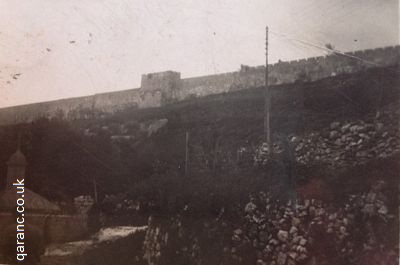
The Mosque of Omar (or the Dome of the Rock) is in another part of the Old City and is surrounded by another wall. This is called the Temple City and is a most magnificent building, with beautifully coloured mosaic work outside and at the entrance to the mosque. The inside is beautifully kept. It is built on Mount Moriah and the top of the original mount is enclosed with carved iron railings. To visit here I had to leave my shoes outside in the charge of a keeper, he giving me some rope slippers to put on, Mount Moriah is still used for sacrifices. It was on this piece of rock that Abraham was to offer up his son when he was stopped by an angel and told to offer up a ram instead.
The priest had some rams tethered at this time and they were being specially fed. I asked the reason, and was told that they were being prepared for a feast in the Temple. The animals were the first born males. They also used goats and oxen for the feast. The Temple belongs to the Mohammedans, Ishmael, who was to have been the victim of the sacrifice, being claimed to be Mohammedan.
In this Temple was a smaller building that was not as elaborate as the main temple. It had steps leading down to vaults. This temple had been built in honour of the Virgin Mary, it has small chambers, in one a niche called the Cradle of Christ, the cradle having been supposedly used when Christ was brought to be circumcised. In this vault are large stone pillars with iron rings fixed in the stonework where Solomon tethered his horses and kept his chariot in later days. The same stables were used by the Crusaders. Many years ago the Moslems used to pass between two of the great pillars that are very close together, and if they could squeeze through it signified that they would be received in Paradise.
Walking along the City Wall after leaving the Temple over-looking the Kedron Valley you could see the tombs of Absalom and Zacharias. You also get a good view of the Mount of Olives. It is believed by the Jews that Christ will sit on the wall to act as Judge on Judgement Day, and that Christ on His Triumphant return to the world will take the place aay from the Moslems and return it to the Jews.
I left the Old City by way of St. Stephen's Gate, passing the Herod and Damascus Gates. Outside the Damascus Gate they hold a cattle market where much shouting and quarrelling takes place on market day. The native is a great driver of bargains and does not part with his money easily. The sale is mostly of sheep and goats and before being taken to market they are scrubbed and cleaned up to show the value of the wool. This process is done in the Pool of Siloam which is on the side of the main road leading to a hill called Aba Tor. On the hill Judas sold his Master for thirty pieces of silver, then felt ashamed of it, so hung himself in a field nearby, this field being Known as the Field of Blood.
Before the riots in Palestine the authorities began some excavations on the Aba Tor and found many old relics including small silver coins called the Widow's Mite. These coins had been placed for safety with the Franciscan Monks, who very kindly showed them to me.
Near the Pool of Siloam is a fountain still in use. They say that the Virgin Mary drew water from this to wash the swaddling clothes of her son, and at this pool in later years Christ sent the blind man to wash and he had his sight restored.
The Wailing Wall in the Old City must not be forgotten. It belongs to the Jews and Hebrews. It is of rough stone blocks shining with age and touch, also kissed by thousands. Pilgrims from all over the world visit it and they chant and pray before it.
I noticed hundreds of large nails knocked into the stonework and was told that each nail indicated a pledge that as the nails cling fast to the wall so will the Jews never forsake their fathers' God. The Jews have been offered untold wealth for it by the Moslems, but they refuse to sell. On the night of Passover this spot was so crowded that the noise of crying and wailing was pathetic to hear. The police and soldiers had to take charge to prevent bloodshed.
Leaving Jerusalem for Bethlehem, on the roadside is a well still used for obtaining drinking water. It is called Mary's Well or the Magic Well. The local natives say this is the place where the Wise Men on their way to see the Babe lost their way and stopped to draw water. They saw the reflection of a star and, taking it for a good omen, they let themselves be guided by it so arrived in Bethlehem. On this road are fields still used by sheep and goats for grazing, watched over by shepherds because of the prowling jackals and hyenas. In one of these fields Ruth and Boaz met.
Coming to a cross-roads - one leading to Hebron and Bethlehem - re the remains of a stone aqueduct by which Pontius Pilate tried to bring water to Jerusalem from King Solomon's Pool on the Hebron road. Having taken part of the Jews' temple fund for this purpose, a quarrel arose between Herod and himself resulting in the work never being completed.
My leave ended, but I must return to Jerusalem later on as there is so much I want to see.
Sister Hughes fascinating war diary continues on the Casanovo Monastery Nazareth World War 2 page.
More War Diaries Nursing Sisters

Former Royal Air Force Regiment Gunner Jason Harper witnesses a foreign jet fly over his Aberdeenshire home. It is spilling a strange yellow smoke. Minutes later, his wife, Pippa, telephones him, shouting that she needs him. They then get cut off. He sets straight out, unprepared for the nightmare that unfolds during his journey. Everyone seems to want to kill him.
Along the way, he pairs up with fellow survivor Imogen. But she enjoys killing the living dead far too much. Will she kill Jason in her blood thirst? Or will she hinder his journey through this zombie filled dystopian landscape to find his pregnant wife?
The Fence is the first in this series of post-apocalyptic military survival thrillers from the torturous mind of former British army nurse, now horror and science fiction novel writer, C.G. Buswell.
Download Now.
Buy the Paperback.
If you would like to contribute to this page, suggest changes or inclusions to this website or would like to send me a photograph then please e-mail me.
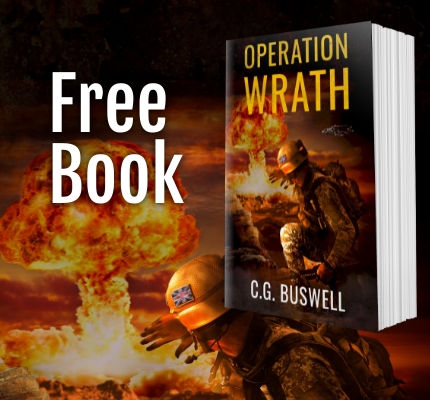
Free Book.
The death of the Brotherhood will be avenged.
RAF gunner Jason Harper and a team of Special Air Service operators are enraged after the death of their brothers by a terrorist drone strike. They fly into south-eastern Yemen on a Black-op mission to gather intelligence and avenge the death of their comrades.
Can they infiltrate the Al-Queda insurgents' camp, stay undetected, and call down their own drone missile strike and get home safely?
Will they all survive to fight another day?
Operation Wrath is a free, fast-paced adventure prequel to the non-stop action The Fence series by military veteran author C.G. Buswell.
Download for free on any device and read today.
This website is not affiliated or endorsed by The Queen Alexandra's Royal Army Nursing Corps (QARANC) or the Ministry of Defence.
» Contact
» Advertise
» QARANC Poppy Pin
» Poppy Lottery
» The Grey Lady Ghost of the Cambridge Military Hospital Novel - a Book by CG Buswell
» The Drummer Boy Novel
» Regimental Cap Badges Paintings
Read our posts on:
Offers
» Army Discounts
» Claim Uniform Washing Tax Rebate For Laundry
» Help For Heroes Discount Code
» Commemorative Cover BFPS 70th anniversary QARANC Association

Present Day
» Become An Army Nurse
» Junior Ranks
» Officer Ranks
» Abbreviations
» Nicknames
» Service Numbers
Ministry of Defence Hospital Units
» MDHU Derriford
» MDHU Frimley Park
» MDHU Northallerton
» MDHU Peterborough
» MDHU Portsmouth
» RCDM Birmingham
» Army Reserve QARANC
Photos
» Florence Nightingale Plaque
» Photographs
Uniform
» Why QA's Wear Grey
» Beret
» Army Medical Services Tartan
» First Time Nurses Wore Trousers AV Anti Vermin Battledress
» TRF Tactical Recognition Flash Badge
» Greatcoat TFNS
» Lapel Pin Badge
» Army School of Psychiatric Nursing Silver Badge
» Cap Badge
» Corps Belt
» ID Bracelet
» Silver War Badge WWI
» Officer's Cloak
» QAIMNSR Tippet
» QAIMNS and Reserve Uniform World War One
» Officer Medal
» Hospital Blues Uniform WW1
Events
» Armed Forces Day
» The Nurses General Dame Maud McCarthy Exhibition Oxford House London
» Edinburgh Fringe Stage Play I'll Tell You This for Nothing - My Mother the War Hero
» Match For Heroes
» Recreated WWI Ward
» Reunions
» Corps Day
» Freedom of Rushmoor
» Re-enactment Groups
» Military Events
» Remembrance
» AMS Carol Service
» QARANC Association Pilgrimage to Singapore and Malaysia 2009
» Doctors and Nurses at War
» War and Medicine Exhibition
» International Conference on Disaster and Military Medicine DiMiMED
» QA Uniform Exhibition Nothe Fort Weymouth
Famous QA's
» Dame Margot Turner
» Dame Maud McCarthy
» Lt Col Maureen Gara
» Military Medal Awards To QAs
» Moment of Truth TV Documentary
» Sean Beech
» Staff Nurse Ella Kate Cooke
Nursing
Nursing Jobs Vacancies UK
International Nurses Day
International Midwife Day
Info
» Search
» Site Map
» Contact
» Other Websites
» Walter Mitty Military Imposters
» The Abandoned Soldier
We are seeking help with some answers to questions sent by readers. These can be found on the Army Nursing page.
» Find QA's
» Jokes
» Merchandise
» Mugs
» Personalised Poster
» Poppy Badges
» Stamp
» Teddy Bears
» Pin Badges
» Wall Plaques
» Fridge Magnet

